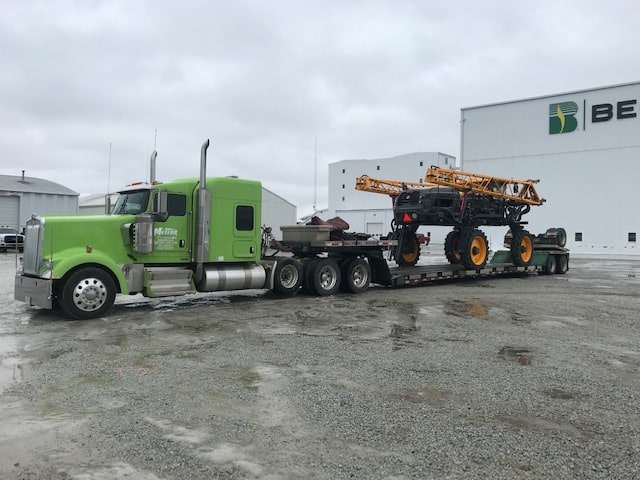What are Outriggers on a Trailer?

William Thomas / January 2021
Outriggers on a Trailer Used For Shipping Heavy Equipment
To haul a tractor with a lowboy trailer that is 1.5 ft. narrower than the tractor, you need to attach special equipment that acts as an expansion support system. Such equipment is called an outrigger and is used to increase the surface area of the trailer deck so that the trailer can support wider heavy equipment. Outriggers are very useful when shipping heavy machinery that have wider separations between the wheels. They make trailers become more versatile and help trucking and delivering heavy and wider loads efficiently and safer.
When it comes to wheeled agricultural heavy equipment hauling, it’s a common occurrence to see trailers use outriggers. The reason why heavy equipment transport experts use outriggers on a trailer is twofold. First, outriggers are used to widen the base of the trailer for stability reasons. They make the heavy equipment harder to tip over or rollover during hauling. This means that the trailer can carry heavier and wide equipment without compromising safety. Secondly, the outriggers are used to hold the wheeled heavy machinery rigidly. If the outriggers are not used, parts of the heavy equipment will be suspended on the edges of the trailer. Which means, the strains and chains used to secure the load will be under high tension when the truck hits the road. As such, the heavy equipment transport will be at risk of wobbling back and forth as the truck accelerates, moves on an even terrain, and breaks. With outriggers in place, it will be difficult for the heavy machinery to swing back and forth, making the trucking and towing smooth and safe.
How are Outriggers Fitted on a Trailer for Safe Shipping
Outriggers, commonly known to most trucking specialists as trunnion or trunnions, are load-bearing equipment that can either be pull out, swing out or attached type. The pull out outrigger is usually made of forged steel in a wedged shape to allow indexing at a right angle. The pull-out is designed with a mounting base that fits in the access spaces on the sides of the trailer. The mounting base features upper and lower mounting brackets and three locking positions for flexibility.
The next type of outrigger is a swing out, which ideally provides a towing solution for wider and oversize load when needed. When not in use, these types of outriggers are locked against the trailer frame. Attached outriggers are also available and are widely used with a wooden outrigger board. As the name suggests, these types of outriggers can be attached and detached when not in use. Among the three types, pull out outriggers provide a more stable load-bearing platform as the cargo doesn’t experience the back and forth movement during trucking.

Transport Your Outriggers Today
Heavy Equipment Transport is always available for a quote. Fill out the form or give us a call now! (888) 730-2951
Trailers Fitted with Outriggers for Transporting Wider Machinery
Agricultural, earthmoving, on any other wheeled heavy load are generally wider. Given that the standard length of most trailers is 8.5 ft. (102 in.) trucking loads wider than 8.5 ft. might pose a challenge. But a drop deck trailer, removable gooseneck trailer, or double-deck trailer fitted with a set of outriggers are an excellent solution for moving most of the wheeled and wide loads. Swing outriggers can add a step-deck trailer with 10 in. bed width to each side while pull-out outriggers will extend to allow a 13 ft. 6 in. wide trailer base.
Choosing a heavy-haul trailer for trucking oversize is a complicate process, but an ideal trailer should have the weight and dimension capacity of the largest intended load. Trailers with the lowest center of gravity are best for trucking and moving wider heavy equipment that requires an extension of the trailer width.
The Versatility of Equipment Transport Trailers Equipped with Outriggers
Most outriggers are made of oak (a strong hardwood) or aluminum forging. The aluminum types are more preferred as they are sturdier and have higher elasticity value. This means that the aluminum made outriggers can bend slightly under load and bounce back after unloading. With an increased trailer base, the trailer can tow a wide variety of cargo with enhanced agility and versatility. For instance, with strong pull-out outriggers, RGN trailers can be increased from the 8.5 ft. standard width to 10 ft. or even 13 ft. for much wider loads and stability when hauling an oversized load.